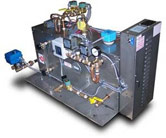Steam is used in a wide range of applications as a heat source and a sanitizing agent.
In breweries, steam plays a crucial role in maintaining high sanitation levels, cleaning brewing utensils and hard-to-reach areas, and ensuring beer flavors remain consistent. For example, many breweries use steam generators to boil wort, which is a highly energy intensive step in the overall brewing process.
This article will discuss how breweries employ steam generators/boilers, compare the use of steam to boil wort versus electric heat or direct fire, and highlight some key advantages of utilizing steam in brewery applications.
How Are Steam Boilers Used in Breweries?

Brewers closely oversee and manage their boiler’s temperature level so the water is heated to a precise point. Since there are many variables at play in this process—such as the desired flavor and the amount of water—the required amount of steam varies widely between each batch.
Sanitizing & Sterilizing
Steam is highly useful for clean in place (CIP) processes for equipment, such as:
- Mash tuns
- Fermenters
- Brite tanks
- Serving tanks
Steam also kills leftover spores and bacteria in these pieces of equipment to acceptable levels.
Cleaning Kegs & Facilities
Even after the completion of the brewing process, beer-makers must store their product in containers with surfaces free from contaminating beer stone or biofilms, which could alter the taste of the beer. Steam generators help remove stickers or biofilms, unclog drains, and assist in eliminating calcified beer stone.
Boiling Wort: Steam vs. Electric vs. Direct Fire
Steam
In the wort boiling process, steam offers key advantages over other methods. For instance, the steam generators used in the brewing process can also be utilized during cleaning and sanitizing operations. Steam also has the fastest temperature ramp rates for the kettle due to shear surface area contact, which is a big plus when dealing with variable temperature requirements. Using steam ultimately allows for greater temperature control, ideal for fine-tuning the brewing process.
Electric
Brewers may require 300-500 amps of electricity or more to power electric brew houses. They also may have to implement 3-phase 480 volt power protocols. Since these requirements are not standardized throughout the country, brewers who use electricity to boil wort must ensure their permits, electrical service upgrades, and infrastructure are in line before they begin operations. This could require the expenditure of many resources.
Direct Fire
This method of boiling refers to a gas burner that is installed on the outside of the kettle. This burners flame heats a diffuser or deflector plate inside a fire box underneath the kettle. One advantage of this method is a reduction in scorch risk. Additionally, direct fire allows the brewer to exercise greater control over temperature ramp rate compared to electric heat.
Why Steam?
Steam generators offer several benefits to breweries:
- Steam temperatures above 284 degrees Fahrenheit safely remove organisms living beneath their own biofilm.
- A dry steam vapor model allows for increased cleaning efficiency, which leads to less operational downtime.
- Steam solutions are eco-friendly, reducing or eliminate effluent issues.
Electro-Steam has over 65 years of experience in the dry steam cleaning industry. We are one of the oldest producers of electric steam generators for original equipment manufacturers, and our catalog contains a wide array of steam generators that are perfect for breweries both large and small.
If you’d like to learn more or want to get started on the next project for your brewery, reach out to us today.

 Proudly Made in the USA
Proudly Made in the USA